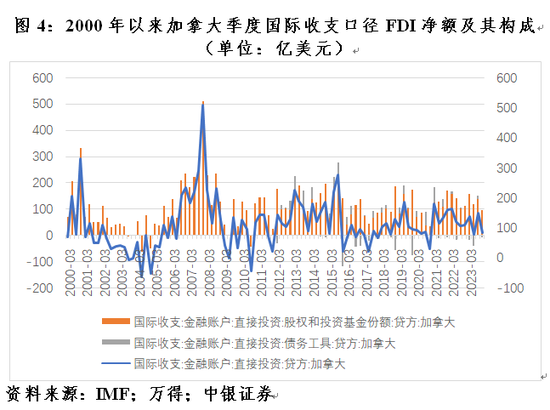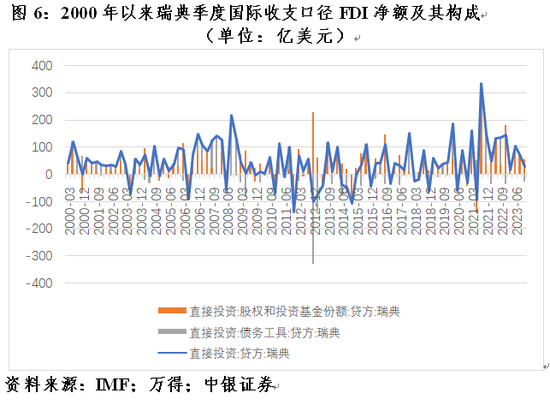Opinion Leader | Guan Tao
As for the statistics of foreign direct investment (FDI), there are mainly two international standards: balance of payments (BOP) and UNCTAD. China's FDI data collected by the United Nations Trade and Development Commission is based on the caliber of the Ministry of Commerce. In recent years, the net amount of FDI in China's balance of payments (that is, the net amount of "direct investment debtor or creditor" under the "financial account" in the balance of payments statement) has more obvious fluctuations than the use of FDI flow data in the Ministry of Commerce. In particular, in the third quarter of 2023, the negative value of China's net FDI in terms of balance of payments for the first time since the data were available has triggered various negative interpretations, which is a specific manifestation of weak social expectations.
However, according to the relevant situation of the world's top ten FDI using economies in 2022 (the United States, China, Singapore, Hong Kong, France, Brazil, Australia, Canada, Sweden and India in turn) measured by the UNCTAD caliber, the two caliber values generally deviate from each other. From a worldwide perspective, the size of balance of payments also fluctuates more than that of UNCTAD. As for the quarterly balance of payments, it is not uncommon that the net amount of FDI is negative, and even the equity investment under FDI is negative. Obviously, any interpretation of the fluctuation of China's net FDI should be very careful and need more solid data support.
Deviation of FDI values from two dimensions from an international perspective
From the ratio of balance of payments and UNCTAD caliber to FDI statistics, from 2000 to 2022, the global average was 138.6%, and the average of the world's top ten economies using FDI was 118.7%. Among the top ten economies, only India is near 100%, Canada is 85.5%, and the other eight economies are all above 100% (see Figure 1). That is to say, among the top ten economies, only India has unified two criteria to submit FDI data to UNCTAD, while other economies have different criteria. It can be seen that the international practice of FDI statistics does not favor the balance of payments.

The net FDI in the balance of payments is usually larger than that in the UNCTAD. China, France, the United States, Sweden and Brazil all deviate by more than 10 percentage points. The proportion of this item in Canada is relatively low, mainly because of the abnormal value in 2004, when the balance of payments caliber was the net inflow of FDI of $1.5 billion, and the UNCTAD caliber was the outflow of FDI of $400 million, the ratio of the two was - 326.4%. However, from 2010 to 2022, after removing the outliers, the average value of Canada was 105.2%, which was also slightly higher than that of the United Nations Commission on Trade and Development. In the same period, the global average was 130.3%, and the average of the top ten economies was 127.2%. The deviation of the two caliber values of the five economies mentioned above was still more than 10 percentage points, with France accounting for 206.1% (see Figure 1).
In 2023, the net amount of FDI in China's balance of payments is only 26.4% of that of the Ministry of Commerce, the first time since 1997. However, since 1982, when China began to prepare the balance of payments statement, there have been six times when the size of China's balance of payments was smaller than that of the Ministry of Commerce, respectively, in 1983-1986, 1995 and 1996. In 2023, the net inflow of FDI in China's balance of payments will decline by 77.5% year on year. In the same period, among the top ten economies, the net inflow of FDI in the United States and Singapore increased by 1.6% and 17.8% respectively over the previous year, while other economies declined to varying degrees. Among them, Australia, Sweden, Brazil and Canada decreased by 54.4%, 51.3%, 17.0% and 10.2% respectively, and France turned from net inflow to net outflow from the previous year. Moreover, from the perspective of trend, among the top ten economies, the average net inflow of FDI in the United States, Brazil and Australia will decrease by 6.9%, 22.1% and 24.4% respectively from the average in the first five years (2015-2019) of the epidemic, while China, Singapore, Hong Kong, India, France, Sweden and Canada will increase by 3.2%, 59.3%, 2.5%, 5.8%, 11.7%, 170.0% and 8.4% respectively (see Figure 2).

In addition, from the perspective of year-on-year changes, the fluctuation of net FDI in the international balance of payments caliber is greater than that in the UNCTAD caliber. From 2006 to 2022, the standard deviation of year-on-year changes in FDI in the global balance of payments caliber was 2.15 times that of the UNCTAD caliber. Only three of the top ten economies had similar situations, 3.09 times that of China, 1.15 times that of Hong Kong, China, and 1.01 times that of Singapore (see Figure 3). In other words, such as China, where the fluctuation of FDI value in the balance of payments caliber is greater than that in the UNCTAD caliber, it is a rare phenomenon in the top ten economies, but it is not an exception in the world.
It is not uncommon for the above ten economies to have negative quarterly net FDI
From the situation since the first quarter of 2000, the quarterly net FDI in terms of balance of payments of the top ten economies (excluding China) is negative, which can be roughly divided into four situations.
The first situation is that there has never been a negative quarterly net FDI, including Brazil and India.
The second situation is that the quarterly net FDI is negative occasionally (within two times), including Hong Kong and Singapore. Among them, only one net outflow of FDI occurred in Hong Kong, China, in the second quarter of 2019, amounting to US $16.3 billion, mainly because the net outflow of equity investment in the quarter was US $27.1 billion; Singapore's net FDI outflow was US $1 billion in the third quarter of 2002 and US $2.5 billion in the second quarter of 2003, respectively.
The third situation is that the quarterly net FDI is negative for many times (three to ten times), including the United States, Australia and Canada.
The quarterly net FDI of the United States was negative for three times, respectively: the net outflow of $71.3 billion in the first quarter of 2014, mainly because of the net outflow of equity investment of $78.4 billion; The net outflow in the second quarter of 2018 was $6.7 billion, mainly due to the net outflow of debt of related enterprises of $44.6 billion; The net outflow in the second quarter of 2020 was $54.2 billion, mainly due to the net outflow of debt of related enterprises of $86.2 billion.
There were four quarters of negative net FDI in Australia: the net outflow of FDI in the second quarter of 2005 was 38.8 billion US dollars, mainly because of the net outflow of equity investment of 41.8 billion US dollars; In the fourth quarter of 2007, the net outflow of FDI was $100 million, mainly because the net outflow of debt of affiliated enterprises was $8.9 billion; In the fourth quarter of 2022, the net outflow of FDI was US $3.7 billion, of which the net outflow of debt from affiliated enterprises was US $2.9 billion, and the net outflow of equity investment was US $0.8 billion; In the second quarter of 2023, the net outflow of FDI was $1.7 billion, mainly due to the net outflow of equity investment of $1.8 billion. It is worth mentioning that although there was only one quarter of net outflow of FDI in Australia in 2005, due to the large scale of net outflow in that quarter, the net inflow of FDI in the whole year turned from 42.9 billion dollars in the previous year to 25.1 billion dollars in the net outflow. In addition, the net outflow of equity investment in Australia in the first quarter of 2001 and the fourth quarter of 2002 was $1.4 billion and $0.8 billion, respectively. Just because there was a large net inflow of debt from affiliated enterprises, FDI still maintained a net inflow in the current quarter.
Canada had six quarters of negative net FDI, namely, the third and fourth quarters of 2003, the second and fourth quarters of 2004, the second quarter of 2009, and the third quarter of 2010, all of which were related to the net outflow of equity investment in the current quarter (see Figure 4).
The fourth situation is that quarterly net FDI is often negative (more than ten times), including France and Sweden.
Since 2000, France has had 13 quarterly net outflows of FDI, four of which are related to net outflows of equity investment. In addition to these 13 quarters, France has five quarters of net outflows of equity investment under FDI in the same period, just because there is more net inflow of debt from affiliated enterprises, FDI still maintains a net inflow in the current quarter. Since France has three quarters of negative net FDI in 2023, the net inflow of FDI in France in the whole year changed from US $105.4 billion in the previous year to a small net outflow of US $3.9 billion (see Figure 5).

Since 2000, Sweden has had 24 quarters of negative net FDI, more than France, and 15 of them are related to the net outflow of equity investment in the current quarter. In addition to these 24 quarters, Sweden also had three quarters of negative net equity investment under FDI in the same period, just because there was more net inflow of debt from affiliated enterprises, the net inflow of FDI was still maintained in the current quarter. Since Sweden had three quarters of negative net FDI in 2018, the net inflow of FDI in the whole year changed from 24.6 billion dollars in the previous year to a small net outflow of 1.4 billion dollars (see Figure 6).
Rational View on the Sharp Fluctuation of China's Net FDI
Since 2000, China has only had a net outflow of USD 12.1 billion of FDI in the third quarter of 2023, mainly because of the net outflow of USD 17.1 billion of debt transactions of related enterprises in the current quarter. So far, China has not seen a negative quarterly net equity investment (see Figure 7).

Compared with other ten major economies, although China is not as negative as Brazil and India, which have never seen quarterly net FDI since the new century, it should be in the second tier with Hong Kong and Singapore. If a negative net amount of FDI appears, Sweden and France will be unable to sleep at night, and Canada, Australia and the United States will also be shocked. Moreover, the negative net value of FDI in terms of balance of payments seems to be the "standard configuration" in Europe in recent years. In 2023, the net outflow of FDI in the euro area was US $421.3 billion, an increase of 42.3% over the previous year. Since 2018, except for 2020, the net outflow in other years of the euro area was US $260.3 billion on average (see Figure 8). In 2023, the net inflow of the UK will also change from 44.9 billion dollars in the previous year to 48.1 billion dollars in the net outflow.

In the context of counter globalization of "small courtyards and high walls" and "de risking", the sharp decline in China's net inflow of FDI, even the negative quarterly value, is remarkable mainly because it will remind people of the possible industrial relocation, decoupling and chain breaking in China. However, in Mexico, which has benefited from offshore trade and friendly offshore outsourcing in recent years, the fourth quarter of 2023 also witnessed the first time since 2000 that the net FDI was negative, with a net outflow of 1.2 billion dollars, of which the net inflow of equity investment was 700 million dollars, and the net outflow of debt transactions of affiliated enterprises was 1.9 billion dollars. In the whole year, the net inflow of FDI in Mexico was US $30 billion, a decrease of 23.3% over the previous year. In particular, from 2020 to 2023, the average annual net inflow of FDI in Mexico will be US $33.6 billion, 4.6% lower than the average from 2015 to 2019 (see Figure 9). So, can we conclude that the reshaping of the global industrial chain supply chain has not benefited Mexico? Obviously, we should be very cautious in drawing this conclusion.

In the 2023 China Balance of Payments Analysis Report, when explaining the reasons why China's net FDI value in the balance of payments caliber has fallen back from a high level since 2022, combined with the main components of net FDI, it pointed out that the rise in overseas financing costs led to an increase in debt repayment of affiliated enterprises, and more use of domestic low-cost RMB funds (the project had its first annual net outflow in 2023) ; The return reinvestment has fallen back, mainly because some foreign-funded enterprises have transferred some of their investment profits in China to ease the liquidity difficulties of their parent companies or meet the demand for overseas funds, and some foreign-funded enterprises have increased their profit distribution and remitted overseas due to the attraction of high US dollar interest rates; In the environment of tightening external financial conditions, capital investment is also facing problems such as increased difficulty in financing.
Of course, the siphon effect of the strong dollar cycle is not only a problem facing China, but also a global challenge. According to the balance of payments statistics disclosed by the IMF, in 2023, the cumulative net inflow of world FDI will be 432.1 billion US dollars, a decrease of 72.1% over the previous year. The statistics of direct investment in the balance of payments also distinguish between equity investment and bond instruments, but some economies have made a distinction, and some (such as Singapore) have not. According to comparable caliber, in 2023, the cumulative net inflow of equity investment under world FDI will be US $665.9 billion, down 35.1% year on year; The net inflow of debt transactions of affiliated enterprises in the previous year was USD 346.7 billion, and the net outflow was USD 421.2 billion. In the same period, the net inflow of FDI in China decreased, also because the net inflow of equity investment decreased, and the debt transactions of affiliated enterprises changed from net inflow to net outflow.
Since 2024, as the probability of the US economy "not landing" has increased, the market has reassessed the Fed's tightening expectations, and the US dollar index and US bond yield have rebounded, but US stocks have repeatedly hit new highs. In this context, according to the preliminary balance of payments data for the first quarter of 2024, the net inflow of China's FDI in that quarter was US $10.3 billion, a year-on-year decrease of 56.3%, 21.3 percentage points narrower than that of the whole year of last year. Among them, the net inflow of equity investment was $19 billion, down 41.2%; The net outflow of debt transactions of affiliated enterprises was $8.8 billion, down 3.1%. This shows that the impact of the Federal Reserve's tightening on China's use of foreign capital is still further revealed in the aforementioned Annual Report due to the US inflation resilience exceeding expectations.
Source: First Finance
(About the author of this article: Global Chief Economist of BOC Securities)









